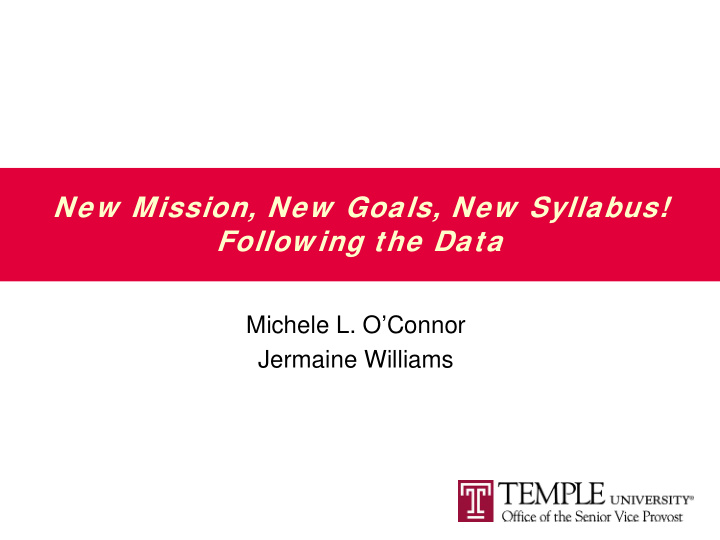



New Mission, New Goals, New Syllabus! Follow ing the Data Michele L. O’Connor Jermaine Williams
Presentation Goals • Change Process • Data • Mission Statement • Goals • Syllabus • Next Steps • Course & Instructor • Audience Feedback
FYS 1001 • 1 semester hour – 80 minutes per week for 11 weeks • Elective credit • Fall semester only • Professional staff • Peer instructor • Approximately 10% of incoming class • Register through advisor
Learning Cycle Single Loop Learning Double Loop Learning Environment Environ- ment . Action Norms Action Norms Questioning
Reference Morgan, Gareth. 1997. Images of organization. Thousand Oaks, CA. SAGE Publications, Inc. This source describes “double loop learning” (Morgan, 1997), the fifth stage of the holographic design where organizations are viewed as brains (i.e., the ability to learn how to learn), that was utilized to facilitate the Freshman Seminar change process.
Step 1: Sensing, Scanning, and Monitoring the Environment – Fall 2005-2006 Environment • An easy “A” Step 1 • Common syllabus, but no consistency • Focus on academic skills and guest speakers Step 3 • Little oversight • Minimal instructor training or follow Step 2 up • CATE results: neutral
Step 2: Comparing information against operating norms • Information: •High school GPA increasing Step 1 •SATs going up •Campus climate •Percent in residence halls increasing •New facilities • Norms: Step 3 •Easy “A” Step 2 •Drill and skill •Perceived as course for at risk students •Little oversight - inconsistency between sections
Step 3: Initiating Appropriate Action Action • Increased number of sections & Step 1 instructors • Introduced population specific sections •Pre-Health •Pre-Law Step 3 • Gathered data to drive discussion Step 2 •CATES •New student survey •Instructor feedback
Step 1: Sensing, Scanning, and Monitoring the Environment – Post-Fall 2006-Spring 2007 Environment • New central administration Step 1 • Record number of admits • SATs improve • Record number of students living on campus Step 3 • Interest of long-term instructors fading Step 2 • New instructors • Collaboration with TLC •Data from •CATEs Step 2b •swot • Program review in 2009
Step 2: Comparing information against operating norms Information • Desired a more academically rigorous course Step 1 • Needed •to improve students’ transition •to reenergize instructors •to require course consistency Step 3 •to prepare for program review Step 2 Norms •Easy “A” •Drill and Skill •Perceived as course for at risk students Step 2b •Little oversight - inconsistency between sections •Lack of community
Step 2b: Questioning whether operating norms are appropriate Questioning •Operating norms no longer Step 1 aligned with vision •Skills vs. Transition •Enhancement vs. Revision •Restructure operating Step 3 norms Step 2 •Data •New mission/goals •New syllabus Step 2b •Improve training •Collaboration with TLC
Step 3: Initiating Appropriate Action Action • Collaborate with TLC Step 1 •Restructured syllabus •Rubrics •Grading Step 3 •Focus on transitions Step 2 • Increased opportunities to build community •Instructors, peer instructors •Revised scheduling matrix Step 2b • Add student voices •Focus group assessment •NSSE
Next Steps Fall 2008 • Increase section collaborations – International student panel – Athlete tailgate initiative • Program evaluations of individual sections • Create advisory board • Increase use of institutional data
Q & A
Thank you !! • Michele L. O’Connor – moconn05@temple.edu • Jermaine Williams – Jermaine.williams@temple.edu www.temple.edu/vpus
Recommend
More recommend